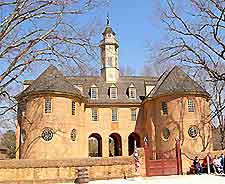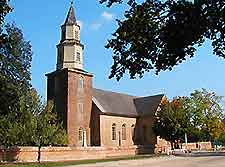Williamsburg History Facts and Timeline
(Williamsburg, Virginia - VA, USA)

One of the most historically rich towns in America is Williamsburg, a settlement in Virginia that was established right at the beginning of the colonization of the country.
Although today there is a typical modern city surrounding the original township, local history is on full display in its fascinating Colonial Williamsburg Historic Area.
Plantation Beginnings
The colony of Virginia was one of the first toeholds established by the English in its new territory across the Atlantic. Jamestown, founded in 1607, was the first settlement to be established in Virginia and the center of early colonial life. After the founding of Jamestown, a large farming area named Middle Plantation was created in 1638 to provide agricultural assistance to the young colony. In fact, as early as 1614, tobacco was being farmed in the area.
Colonial Capital
Jamestown was the original capital of the Virginia colony until it was burned to the ground by rebels during Bacon's Rebellion in 1676. While rebuilding itself, the Virginia government moved to Middle Plantation. The topography of the village proved so much better than Jamestown's original geography that the governor decided to stay. In 1699, the history of Williamsburg truly began, when it was renamed to honor England's King William III and officially designated as the capital of the Virginia colony.
A new capital city was laid out in the heart of the plantation, with the Capitol Building at its core. Today, the city's central square and its original street grids are known as Colonial Williamsburg, a wonderfully preserved living museum showcasing life in colonial America at the beginning of the 1700s. It is a national park and one of the country's most popular and most interesting historic attractions.
The American Revolution and Civil War
When the American Revolutionary War broke out in 1776, the capital was moved to Richmond for better protection. Although the seat of government would never return to Williamsburg, the town remained an important center of planning and conventions. Unfortunately, its high ground location meant it was not connected to the growing nation's canal and river transportation network, and so Williamsburg slowly lost out to the new cities emerging along the banks of America's mighty rivers.
During the Civil War, the town was the site of the Battle of Williamsburg, when the Union Army vanquished the Confederates in April 1862, during the Southerners' campaign to blockade the James River and cut off supplies to Richmond. After they were sent packing, the freed slaves moved in and looted the place.

Revival
By the beginning of the 20th century, Williamsburg seemed lost to history. It was a sleepy town where its original colonial buildings were interspersed with new developments, both commercial and residential. In 1907, the first of the town's deteriorating colonial buildings, the Bruton Parish Church, was saved and restored by its pastor, Reverend Dr. W.A.R. Goodwin.
Realizing there were many other historically important buildings falling apart, Dr. Goodwin initiated a push to create a living museum in what is now Colonial Williamsburg, Virginia's most popular tourist attraction. With a major financial injection from the industrialist John D. Rockefeller Jr., the dream was realized and the 300-acre / 120-hectare historic site was protected and restored.
Today, tens of thousands of visitors come every year to experience the history of Williamsburg by watching craftspeople at work in traditional shops, and by walking around the original location of the capital with all its glorious buildings perfectly restored. Staff dress in period costume and perform trades exactly as they were carried out more than 300 years ago.
 One of the most historically rich towns in America is Williamsburg, a settlement in Virginia that was established right at the beginning of the colonization of the country.
One of the most historically rich towns in America is Williamsburg, a settlement in Virginia that was established right at the beginning of the colonization of the country.